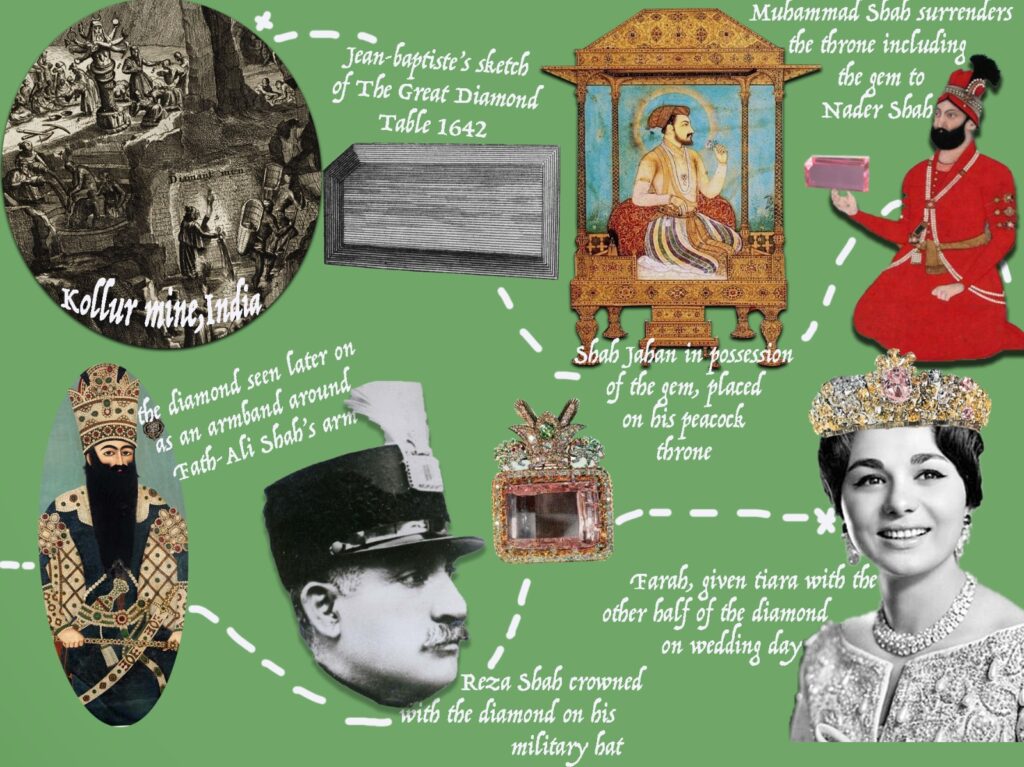The Great Table Diamond… have you ever heard of a diamond split in two that never left each other’s side?
Pulled out of the heart of the Kollur mine in Golconda, which is the source of some of the rarest natural diamonds in the world, it is the largest pink diamond to ever exist.
It has travelled through the hands of many kings and rulers, it has seen the rise and fall of dynasties, war and blood, it has been split in two, taken from one country to another and yet it has outlived all it’s conquerors and still remains one of the most exquisite diamonds in the world.
In 1642 Jean-Baptiste Tavernier who was a connoisseur of diamonds and often bought them for the French crown travelled to India and sketched this rare diamond and eternalised it in his diary by naming it the “Diamanta Grande Table”.
The diamond table was in the possession of Shah Jahan, the Mughal emperor and was placed on his famous peacock throne in Delhi.

In 1739, when the Mughal empire was weak the Persian ruler, Nader Shah attacked the North and Muhammad Shah had to surrender all his riches. Among them was the peacock throne that included The Great Diamond Table.
This diamond was passed on to the rulers and dynasties of Persia one after the other after the assassination of Nader shah. However somewhere throughout this succession, the diamond disappeared. For years, no one saw the diamond. Until many years later some shahs of Iran were seen wearing a pink diamond that looked an awful lot like The Great Table Diamond but much smaller in size. Among these shahs was Fathali Shah who used to wear it on an armband and was said to love it very dearly, so dearly that his name is actually engraved on the side of the diamond. The same rock was later on placed on the crown which Reza Shah wore on his coronation and was used for the same purpose when Mohammad Reza Shah became the last king of Iran.
This is where things start to get interesting. The diamond on the shah’s crown, which was the same as the one Fath Ali Shah wore around his arm, seemed extraordinarily similar to The Great Table Diamond in colour and clarity but not in size, as a result the mystery lingers till the day of Mohammad Reza Shah’s marriage to his third wife, Farah.
On the day of the wedding while the Shah was wearing his crown, jewelled by the beautiful pink gem, he crowned his new wife with a tiara designed by the jeweller Harry Winston, that had an eye-catching, gorgeous pink diamond in the centre that matched the diamond on his crown perfectly. The tiara was placed on Farah’s head and the mystery was finally solved. At some point in history The Great Table Diamond was split in two, one became the Daria-i-Nur meaning the sea of light and the other, smaller in size, named Nur-al-ain meaning the light of the eye.
When researchers laid the two stones side by side they could see that they were the same in every aspect and when put next to each other they matched the sketches of Jean-Baptiste Tavernier. Today, everyone who wishes to see them, can visit The Treasury of National Jewells inside the Central Bank of Iran.
Finally after 2 centuries, the mysteries and myths that this precious and unique diamond was shrouded in was now uncloaked.
